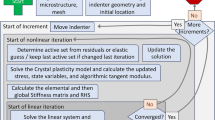Abstract
In an irregular prism tensegrity, the number of force equilibrium equations is less than the number of unknown parameters of nodal coordinates and member force ratios. As a result, the form-finding process normally becomes nonlinear with additional conditions or needs to be carried out with the use of iterative procedures. For cases of irregular prism tensegrity which involves large number of members, it was found that previously proposed methods of form-finding are not practical. Moreover, there is a need for a form-finding approach which is able to cater to different requirements on final configuration. In this paper, the length relation condition is introduced to be used in combination with the force equilibrium equation. With the combined use of length relation and equilibrium conditions, a linear form-finding approach for irregular prism tensegrity was successfully formulated and developed. An easy-to-use interactive form-finding tool has been developed which can be used for form-finding of irregular prism tensegrities with large number of elements as well as under diverse specific requirements on their configurations.













Similar content being viewed by others
References
Duffy, J., Rooney, J., Knight, B., & Crane, C., III. (2000). A review of a family of self deploying tensegrity structures with elastic ties. Shock and Vibration Digest, 32, 100–106.
Faroughi, S., Kamran, M. A., & Lee, J. (2014). A genetic algorithm approach for 2-D tensegrity form finding. Advances in Structural Engineering, 17, 1669–1679.
Feng, X., & Guo, S. (2015). A novel method of determining the sole configuration of tensegrity structures. Mechanics Research Communications, 69, 66–78.
Fuller, R. B. (1962). Tensile-integrity structures. United States Patent 3,063,521.
Fuller, R. B., & Marks, R. (1960). The dymaxion world of Buckminster Fuller. New York: Reinhold Publications.
Knight, B., Zhang, Y., Duffy, J. & Crane, C. (2000). On the line geometry of a class of tensegrity structures. In Proceedings of a symposium commemorating the legacy, works and life of Sir Robert Stawell Ball upon 100 Anniversary of A Treatise on the theory of Screws, July 9–11, 2000 (pp. 1–29). University of Cambridge.
Koohestani, K. (2015). Reshaping of tensegrities using a geometrical variation approach. International Journal of Solids and Structures, 71, 233–243.
Koohestani, K., & Guest, S. D. (2013). A new approach to the analytical and numerical form-finding of tensegrity structures. International Journal of Solids and Structures, 50, 2995–3007.
Lee, S., Gan, B. S., & Lee, J. (2016). A fully automatic group selection for form-finding process of truncated tetrahedral tensegrity structures via a double-loop genetic algorithm. Composites Part B Engineering, 106, 308–315.
Lee, S., & Lee, J. (2014a). Form-finding of tensegrity structures with arbitrary strut and cable members. International Journal of Mechanical Sciences, 85, 55–62.
Lee, S., & Lee, J. (2014b). Optimum self-stress design of cable–strut structures using frequency constraints. International Journal of Mechanical Sciences, 89, 462–469.
Lee, S., & Lee, J. (2016). A novel method for topology design of tensegrity structures. Composite Structures, 152, 11–19.
Motro, R. (2003). Tensegrity: Structural systems for the future. Netherland: Elsevier.
Ohsaki, M., & Zhang, J. Y. (2015). Nonlinear programming approach to form-finding and folding analysis of tensegrity structures using fictitious material properties. International Journal of Solids and Structures, 69–70, 1–10.
Pugh, A. (1976). An introduction to tensegrity. Berkeley: University of California Press.
Skelton, R. E., Adhikari, R., Pinaud, J.-P., Chan, W., & Helton, J. (2001). An introduction to the mechanics of tensegrity structures. In Proceedings of the 40th IEEE conference on decision and control, 2001 (pp.4254–4259). IEEE.
Snelson, K. (1965). Continuous tension, discontinuous compression structures. United States Patent 3,169,611.
Tibert, G., & Pellegrino, S. (2011). Review of form-finding methods for tensegrity structures. International Journal of Space Structures, 26, 241–255.
Zhang, P., Kawaguchi, K. I., & Feng, J. (2014a). Prismatic tensegrity structures with additional cables: Integral symmetric states of self-stress and cable-controlled reconfiguration procedure. International Journal of Solids and Structures, 51, 4294–4306.
Zhang, L.-Y., Li, Y., Cao, Y.-P., & Feng, X.-Q. (2014b). Stiffness matrix based form-finding method of tensegrity structures. Engineering Structures, 58, 36–48.
Acknowledgements
This research was supported by Basic Science Research Program through the National Research Foundation of Korea (NRF) funded by the Ministry of Education (2016R1A2B4014562).
Author information
Authors and Affiliations
Corresponding author
Appendix
Appendix
Process of derivation of Eq. (7) is shown in this appendix.
Equations (5) and (6) are first reproduced:
From the second equation of Eqs. (5) and (6):
which can be combined to yield:
Since (\(\bar{L}_{{t_{1} }}\), \(\bar{F}_{{t_{1} }}\)) and (\(\bar{L}_{{c_{n} }}\),\(F_{{c_{n} }}\)) are pairs of vectors with similar orientations,
From the first equation in Eq. (6),
which can be rewritten as,
Considering the first equation in Eqs. (5), (7) is finally obtained:
Rights and permissions
About this article
Cite this article
Moghaddas, M., Choong, K.K., Kim, JY. et al. Linear Form Finding Approach for Regular and Irregular Single Layer Prism Tensegrity. Int J Steel Struct 18, 1654–1665 (2018). https://doi.org/10.1007/s13296-018-0060-8
Received:
Accepted:
Published:
Issue Date:
DOI: https://doi.org/10.1007/s13296-018-0060-8




